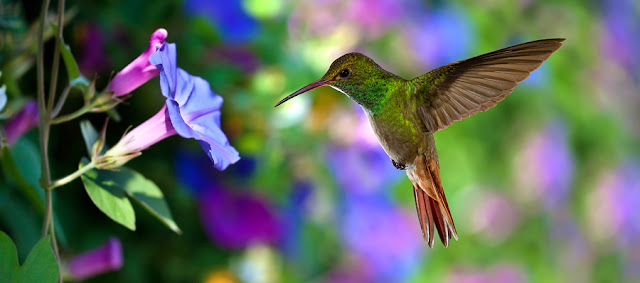Creating a Hummingbird Habitat in Your Backyard
Hummingbirds are beautiful and fascinating creatures. With their bright colors, quickness in flight and amazing acrobatic abilities, these tiny birds are often viewed as resplendent jewels and a welcome addition to any garden.
Florida Hummingbirds
In Florida, there is only one species of hummingbird native to the state, the Ruby-Throated Hummingbird, and most others only appear accidentally as they migrate south for the winter. The appearance of hummingbirds has decreased in recent years, at least in part due to their natural habitat diminishing thanks to urban growth and land development. This can make attracting hummingbirds to a garden quite difficult, and some might even consider it an art form.
Providing Nectar to Attract Hummingbirds
Hummingbirds have a fast metabolism and their flight patterns and habits require the use of a lot of energy. They need a constant supply of food, so one of the primary ways in which gardeners are successful in attracting them is by providing nectar. The hummingbirds gravitates toward a garden filled with vibrant red and orange colored flowers. The best flowers for attracting hummingbirds often have tubular or trumpet-shaped flowers and a long blooming season. The firebush, firecracker plant, coral honeysuckle, snapdragon and Mexican sunflower are excellent choices.
A Continuous Blooming Season
Regardless of which varieties of flowers a homeowner selects for a backyard hummingbird garden, it is important to consider when the flowers will bloom. Ensure that nectar is available to the birds whenever they visit. A gardener who fails to do this will often discover that the birds have left the property and may not return. The most successful garden selection includes varieties of both annuals and perennials which have different growing periods. This will help to ensure steady blossoms from spring to fall and possibly even a year-round nectar source.
How to Plan Out Your Backyard Hummingbird Garden
When planting a hummingbird garden, it is important to not only offer vibrant colors and tasty nectars, but to create a habitat that offers shade, shelter and security. A tiered garden created by incorporating dwarf trees, flowering bushes and herbs offers hummingbirds places to rest in flight, take shelter from predators and build their nests.
If a yard is small, an existing larger oak tree, trellis, shed, covered deck or other structure can be used to support hanging vines. Pots and window boxes also offer additional places to plant flowering varieties, creating the tiered effect that hummingbirds prefer. Whatever varieties a garden offers, it is always important to carefully consider the distance between plants to allow enough room for their growth and the flight patterns of visiting hummingbirds.
Encouraging Nesting
For gardeners who hope to encourage visiting hummingbirds to nest in their yard, adding fuzzy plants often helps. The soft plant fibers of pussy willows, cinnamon ferns and catkin-bearing trees are a preferred material for nest lining for hummingbirds because of the soft and supple qualities that the blooms of these plants offer. Moss and lichen that grow naturally on trees should not be removed in a hummingbird garden, as they are important materials used to camouflage nests, eggs and baby birds.
Cleanliness- An Essential Component
Hummingbirds are quite fastidious about their environment, and they prefer an area that is clean and well maintained. To attract them, gardens must be properly cared for. Prune bushes and shrubs regularly, remove dead leaves, never allow overgrowth and watch for the appearance of fungus or mold. Keep the garden properly watered using a mister which doubles as a bath for birds on the fly.Organic Gardening Practices
When maintaining a hummingbird habitat, it is important to remember that this species of bird is somewhat fragile, and they benefit greatly from organic gardening practices. The use of pesticides and insecticides near hummingbirds exposes them to potentially deadly toxins and eliminates an important part of their diet, the spiders and small insects that they feed on for protein.
Simple organic solutions for controlling damaging pests in a garden include starting with healthy plants, controlling the saturation of soil, hosing off the leaves, hand picking aphids from bushes and pruning dead leaves and decaying plant life. It is also a good idea to research the soil in an area in advance of starting a garden to ensure proper pH levels and composition for the flowers being planted there. Use organic fertilizer or compost to supplement, as appropriate.
Hummingbirds are beautiful, exotic creatures that enhance gardens. They also play a vital role in supporting native plant life by acting as pollinators. Attracting them requires patience and persistence, but once a hummingbird finds your garden, they will often return frequently and provide immense enjoyment for the entire family.
If you are searching for ideas for your own hummingbird backyard oasis or simply want to visit these beautiful birds and enjoy watching them in flight, we welcome you to view our botanical collection at Flamingo Gardens. Our seasonal visitors include several different species of hummingbirds including the majestic Ruby Throat Hummingbird.
Our gardens include over 3,000 species of beautiful wildflowers, flowering plants, trees and bushes in a serene setting, perfect for the entire family to enjoy. Spend a day with us to learn more about the hummingbird and many of Florida's other amazing native wildlife and plant life. You are certain to gain a new appreciation for these amazing creatures and leave feeling inspired to create your own hummingbird backyard habitat.






Very nice article, we get the Ruby throated Hummingbird in Fort Lauderdale, we have lots of live oaks in our neighborhood.
ReplyDelete